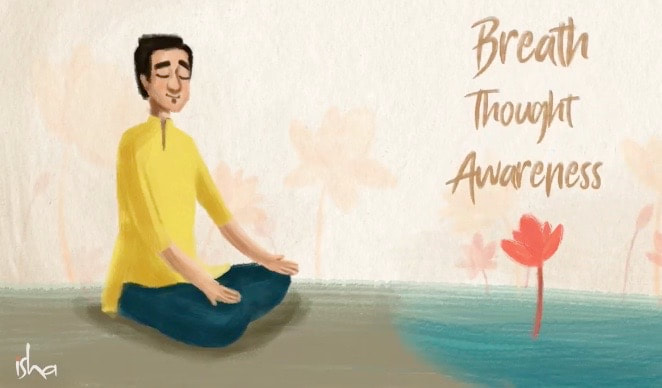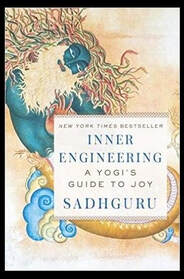|
Inner Engineering Online : 7 Sessions
- A Yogi's Guide to JOY
|
Inner Engineering 7 Sessions COURSE
WHY Inner Engineering
- User Manual for being Alive Book - See Below |
|
BOOK - Inner Engineering
The book is divided into two sections. - Part One contains five chapters: - When I Lost My Sense; - The Way Out Is In; - Design Your Destiny; - No Boundary, No Burden; - ...And Now, Yoga. - Part Two has four chapters: - Body; - Mind; - Energy; - Joy. The first chapter in Part One sets the scene with a brief autobiographical account of Sadhguru's life, the primary focus of which is to recount the spiritual experiences of the writer which later paved the path of his life; hence aptly titled When I Lost my Sense. The second chapter, The Way Out is in, talks about the need for a paradigm shift in the seeking of joy, which Sadhguru believes is the ultimate goal of all human beings. He prescribes looking within at the source of experience to seek joy as opposed to trying to find it in the outside surroundings. Similarly, he advises not to find a way out of suffering, but rather find it inwards. In the third chapter, Design your Destiny, Sadhguru gives a guarantee to the reader: do the right things and right things will for sure happen to you. Taking action in your hands is the key to designing your own destiny. The fourth chapter, No Boundary No Burden, is about the nature of the word responsibility in the context of Inner Engineering philosophy, and cultivating the ability to be responsible/responsive in life. Responsibility is defined as the ability to respond to everything that is in human experience and it is advised that humans understand their capacity to be limitlessly 'responsible' by shedding the burden of enslaving themselves with boundaries. The last chapter of part one, "...And Now Yoga", elaborates upon the true nature of yoga, the concept of the five koshas, the types of yoga, and finally the idea of finding the perfect alignment with existence. Part 2 of the book explores the concept of layers or sheaths in a human being's identity. There are three individual sections in this part, titled Body, Mind, and Energy which deal with the first three of these layers. Each section is further divided into subsections, with each subsection ending with a Sadhna (practice) section which outlines short spiritual practices to incorporate the philosophical point discussed. Part 2 ends with a brief section called Joy: - The Beginning, which outlines the need of joy in human beings' lives and the aim of the author to bring joy within people's consciousness. The book ends with a glossary of terms and a brief introduction of Isha Yoga Foundation. |
Excerpt from : https://www.yogajournal.com/yoga-101/inner-engineering-sadhguru-joy/
Uncovering the Source of Happiness Let us start with a single question: what do we consider to be a state of well-being? Very simply, well-being is just a deep sense of pleasantness within. It goes as follows:
But how many times in your life have you lived an entire day blissfully—without a single moment of anxiety, agitation, irritation, or stress? How many times have you lived in utter and absolute pleasantness for twenty-four hours? When was the last time it happened to you? The amazing thing is that for most people on this planet, not a single day has happened exactly the way they want it! Of course, there is no one who has not experienced joy, peace, even bliss, but it is always fleeting. They are unable to sustain it. They manage to get there, but it keeps collapsing. And nothing earth-shattering needs to happen for it to collapse. The simplest things throw people off balance, out of kilter. Sound familiar? Happiness as an Essential Need Why do you need to be pleasant within? The answer is self-evident. When you are in a pleasant inner state, you are naturally pleasant to everyone and everything around you. No scripture or philosophy is needed to instruct you to be good to others. It is a natural outcome when you are feeling good within yourself. Inner pleasantness is a surefire insurance for the making of a peaceful society and a joyful world. Besides, your success in the world depends essentially on how well you harness the prowess of the body and mind. So, in order to achieve success, pleasantness has to be the fundamental quality within you. Above all, there is substantial medical and scientific evidence today that your body and mind function at their best when you are in a pleasant state. It is said that if you can remain blissful for twenty-four hours, your intellectual capabilities can be almost doubled. Just settling the internal muddle and allowing clarity to surface can achieve this. Now, the same life energy that you refer to as “myself” has sometimes been very happy, sometimes miserable, sometimes peaceful, sometimes in turmoil. The same life energy is capable of all those states. So, if you were given a choice about the kind of expression your life energies should find, what would you choose? Joy or misery? Pleasantness or unpleasantness? The answer is self-evident. The ways may vary from person to person. But whether you’re trying to make money, hitting the bottle, or attempting to get to heaven, pleasantness is the only goal. Even if you say you are not interested in this world and your mission in life is only to get to heaven, you’re still only searching for pleasantness. If people had told you since your childhood that God lives in heaven, but heaven is a horrendous place, would you want to go there? Definitely not! Essentially, the highest level of pleasantness is heaven; unpleasantness is hell. So, some think it’s in the wine, and others think it’s in the divine, but pleasantness is what everyone’s seeking. The only thing that stands between you and your well-being is a simple fact: you have allowed your thoughts and emotions to take instruction from the outside rather than the inside. Excerpted from Inner Engineering, reprinted with permission from (Spiegel & Grau Hardcover/Random House). About the Author Sadhguru is known around the world for the large-scale humanitarian, educational, and environmental projects carried out by the Isha Foundation, which he founded in 1992. He has been an honored guest and speaker at the United Nations, The World Economic Forum, Harvard, Wharton, Microsoft, TED, Google, and more, where he has shared his mission to improve the quality and experience of life on an individual and global scale. |
|
DISCLAIMER The information in this web site is provided for purpose of sharing; "as is" and "as available" basis, and without any representations, warranties or conditions of any kind, whether express or implied, and including without limitation implied warranties of merchantability, fitness for a particular purpose, performance or durability.
|




